Bringing a pet into the home is an exciting experience, and with it comes the hope of a long, happy life together. However, sometimes there are bumps in the road. Families adopt animals with the best of intentions, but when things get challenging at home, an animal can end up right back in the shelter. Sadly, statistics show that each time an animal returns to a shelter, the chances of adoption can decrease. It is the goal of the Virginia Beach SPCA to provide the right tools and resources to make all adoptions lasting adoptions.
The Keys to Success
Basic Needs
Make sure all of your pet’s needs are met. As with humans, our pets have basic needs that are essential to health, wellbeing, and even survival. When a need is not met, it creates an unsteady foundation upon which health and behavior issues will almost certainly arise. All pets need the following:
- Sleep
- Food & Water
- Potty Breaks
- Mental Stimulation
- Exercise
- Human Attention
If all of these needs are being met and your animal is still struggling, speak with your vet about other options or seek out professional training to work on desensitization.
Enrichment
Beat your pet’s boredom with enrichment activities. The brain is an organ that needs to be engaged and exercised. Without mental stimulation, the brain can atrophy and weaken which can lead to all kinds of behavior changes and challenges. Utilize the following activities to make sure your pet is receiving the enrichment they need. And remember, fixing an issue is always more difficult than preventing one:
- Training Exercises
- Puzzle Feeders
- Treats
- Licki Mats
- Dog Chew Toys or Kong Wobbles
- Cat Crinkle Balls
Enrichment can help with issues such as destructive behavior. If there are no underlying issues and your pet is properly trained, providing enrichment is a great way to avoid unwanted behavior.
Socialization
Prep your pet for positive experiences with people and pets. Interaction with people outside of the home is part of any pet’s life, whether it be with the mail person, the HVAC person, other dogs in a dog park, or even weekend guests. Being able to foster comfortable interactions with these unfamiliar faces is not only important for your visitors but especially critical for your pet’s nervous system. The key to comfortable interaction lies in socializing our pets early while also making sure we properly and safely introduce new spaces and faces.
When introducing your pet to something new:
- Establish a Routine
- Move Slowly
- Be Patient
- Stay Calm
- One Person or Pet at a Time
- Allow Them to Sniff Around
Unfamiliar spaces can be scary for pets, which might make them reactive. Being patient can avoid problems and get your pet settled in more quickly. A pet that is stressed is not in the right head-space to be a great companion. While you may want to automatically cuddle and love all over them, it may take a little time before they are ready, and that’s okay. For additional information on how to introduce a new pet to your home, read about introducing dogs here and introducing cats here.
Understanding the Reason Behind the Behavior
When dealing with a behavioral issue, it is important to decode what your pet is feeling. We checked in with our friend Crystal Partain, a Dog Trainer with The Freckled Paw, and she offered some great insight into our furry friends’ behavior. First and foremost, if they are acting out or showing signs of stress, there is always a reason! Consider what has happened in the recent month and answer the following questions:
- Is there any change in the animal’s routine?
- Do you suspect a medical issue to be the reason your animal’s behavior has changed? If you haven’t done so, consider taking your pet to a vet to see if there are any underlying issues.
- What is your pet’s training background? Have they had puppy obedience, basic obedience or specialized training before?
- How old is your pet? Adolescent animals are not as skilled in managing their emotions and may require a little extra patience.
There are many common issues that potentially have simple solutions.
- If your young dog is becoming reactive, be patient with them. They might simply be having big adolescent feelings about things. This is when annoying, embarrassing behaviors come into play, and they can be changed fairly quickly if caught early. If it becomes unmanageable, you can also work one-on-one with a trainer to come up with a plan. You can find our list of recommended dog trainers here.
- Pets destroying furniture and potty training issues are two of the most frustrating things pet owners have to deal with. For dogs, you can set them up for success by ensuring that they are properly crate trained and making sure the areas where they will be spending the majority of their time are free of anything you don’t want damaged. Cats have specific needs when it comes to litter boxes, and you can read more information by clicking here. They also need to be provided adequate scratching posts to discourage them from scratching on furniture. There are quite a few options at your local pet store including posts and furniture tape, both of which can be a great deterrent to unwanted scratching.
- Pets take time to get used to a new home and decompress. If you just brought home your furry friend, remember the rule of 3s. In three days, your dog or cat will have figured out where they are. In three weeks, they will have figured out your routine, and in three months, they will begin to ‘unpack their bags.’ Be understanding throughout this process!
Being a pet parent requires dedication, patience and love. If you are ready to commit to providing those three things, you are on the right track! If you are seeking additional guidance, speak with your veterinarian or contact one of our recommended professional trainers.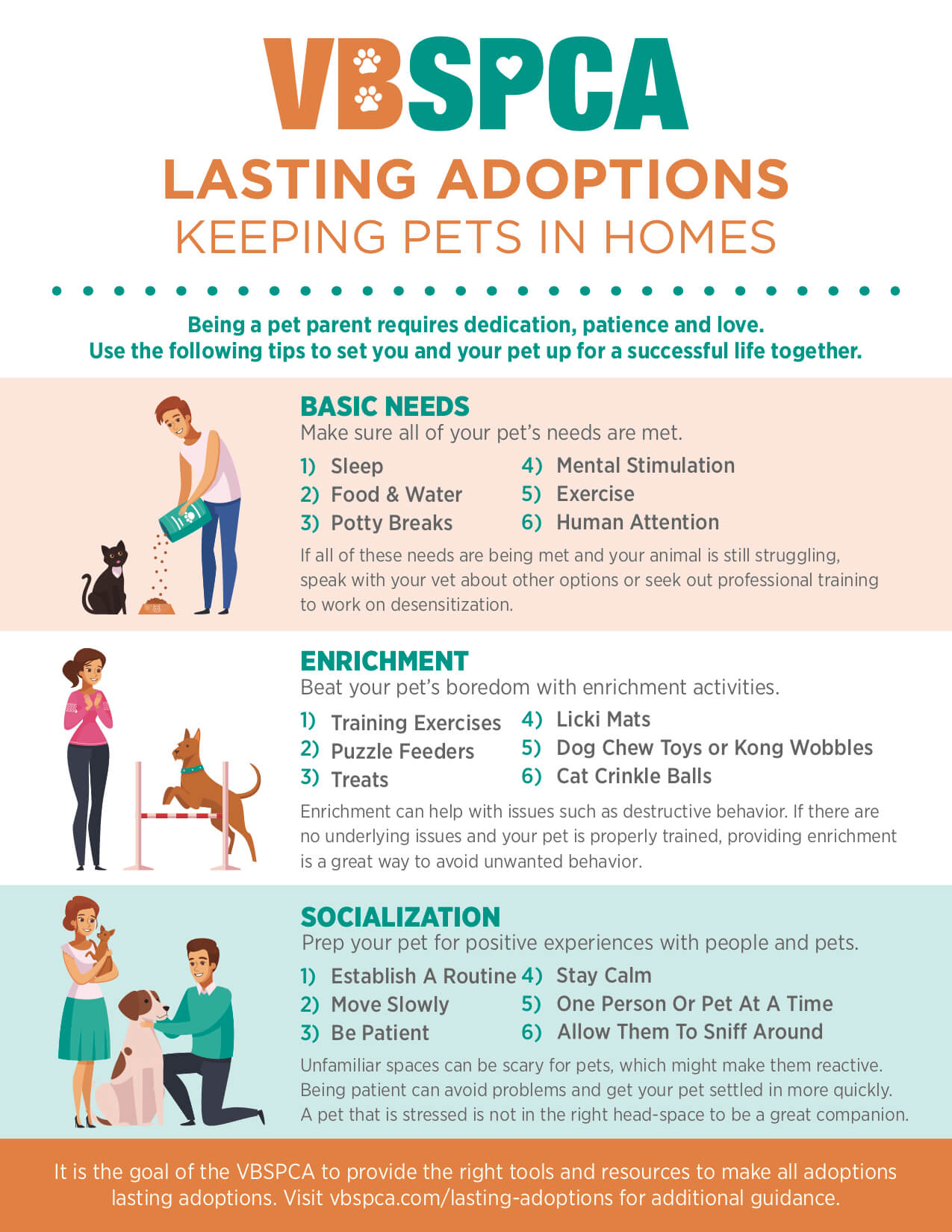


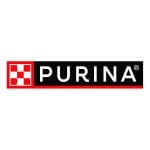

Last Updated: June 1, 2022 by vbspcaadmin
VBSPCA 2020 Lifesaver Award Recipient: Arvalla “Arvie” Larsen
The 2020 recipient of the Virginia Beach SPCA Lifesaver Award is Arvalla “Arvie” Larsen, an inspiring example of generosity, selflessness, and compassion in service to the animals. This annual award has been given out for the past 10+ years, and it honors individuals who demonstrate an unwavering commitment to the VBSPCA mission of compassion. Larsen has consistently proven that she is deserving of this very special award and we are thrilled to recognize her in this way.
Larsen’s journey with the VBSPCA started in 1980 while she was serving in the U.S. Navy. For many years, she donated part of her paychecks to the shelter as a way of supporting the animals. After retiring in 2013, she took a gap year and decided to put her compassion into action. Her volunteer orientation was in 2014, and ever since then she has helped clean the cattery a few days every single week.
In her off time, she continues to serve animals in the Virginia Beach community. She is a level 4 wildlife rehabber with Second Chance Wildlife and has successfully released multiple animals after nursing them back to health. “I hope to help animals live a long life and a better life for as long as I can,” she says.
Stemming from her passion for animal welfare, Larsen believes that government-run programs like animal control need help from dedicated people working in nonprofit organizations. According to her, the problem is too big for one shelter to handle. “Nonprofits are extremely important in our community because they can give a helping hand to state-run shelters,” she said.
Larsen credits her work ethic and dedication to her military background. She joined the U.S. Navy in 1964 and served until 1984, transitioning into working veterans affairs at Tidewater Community College. She recalls how different the culture was for women due to WAVES still being active, saying “we weren’t really in the Navy.” However, one thing she is grateful for during her time of service is teaching her the benefit of having structure.
While she is an integral part of daily life at the shelter, Larsen claims that she almost didn’t show up to her volunteer orientation. Her introverted personality made her nervous to take the first step, but once she got started, all of her worry about volunteering went away. “I work in the cattery and I love it because it gives me a little time to myself in the mornings before the rush starts. There’s a calming feeling of working around animals early in the morning, and I am so happy to have had this opportunity,” she said.
No matter what arena she finds herself in, Larsen has lived a life in service of animals. Her selflessness and dedication are commendable qualities to have, and the VBSPCA has been fortunate to have her as a committed volunteer in service to the animals.
“I hope to help animals live a long life and a better life for as long as I can.” – Arvie Larsen.
Last Updated: June 1, 2022 by vbspcaadmin
Happy Tails — Goose
Every single animal that comes through our shelter has a story. Some are complex, many are sad, but all of them get better the minute they arrive at the Virginia Beach SPCA. Goose was a shy adolescent dog who needed a home that would give him a lot of patience and love. He found his perfect home with adopter Kendall and lab sister Heisty who helped him regain confidence. We recently caught up with Kendall, and she gave us an update on Goose, Heisty, and their happy life together.
How did you find Goose and what was your adoption experience?
I have had my dog Heisty for three years, she is a yellow lab and also a rescue. She loves other dogs, but we never really were looking, until COVID hit and my office told everyone to work from home for the foreseeable future. I thought it would be the perfect time to take in a rescue since I would have plenty of time to spend with them. I searched the VBSPCA website and saw many adorable pups I knew would be adopted, then I came across a fluffy white cloud that had been there for over a month and needed multiple visits before he could be adopted. I knew right away this was the pup I wanted! My family has been involved in animal rescue my whole life so I was ready to put in the extra time he would require. During our first meeting he started to warm up but was still very hesitant. One of the employees told me he was extremely frightened of men. Each visit he would perk up more to see my familiar face and on the fourth I did the big test — introducing him to Heisty. I was so nervous and was praying all day they would click. They immediately loved each other and even started playing, and I knew she would be the perfect big sister. Throughout the visits, he had not let me do more than pet him gently, but when we arrived at our home I sat on the couch and he jumped up to cuddle!
It has been four months since I adopted Goose and he is doing great. Each day I would see him get more and more comfortable and have had plenty of time to work with his confidence since I work from home. I take him to Sandbridge on weekends to see my parents and sister. The first visit he would not let my dad within 20 feet of him, but now he runs and jumps on my dad and follows him all around the yard. I think he may be his new favorite. While I work at home, he plays with his sister all day and takes naps with her at my feet. He is also the fan favorite of Zoom calls as he loves jumping on my chair and saying hi. I could not imagine my life without Goose at this point and I know Heisty feels the same way! I can tell he finally understands that he is here to stay forever.
We’ve heard that he is quite the jokester, what are some of his funny quirks?
He has such a unique personality. Goose is always sticking his tongue out, but just enough to where it looks hilarious — I call it his resting face. When I lay on the couch he will jump on and just stand on top of me without moving. If I try to move him he will lay on me and will not budge. He loves jumping on the couch like a kid and body slamming his sister then pouncing on me. I cannot move an inch in my house without him following me and he is the biggest momma’s boy around. If he knows you, he will give you the biggest jump hug of your life when you see him!
Goose loves his walks and going to see his neighborhood friend Bentley at the dog park. I take Goose and Heisty to the beach often, although he only likes to dip his paws in the water so far and watch his sister swim through waves. He does enjoy digging in the sand and politely sitting next to the closest family with food. He also loves to play his own version of fetch where he lets Heisty get the ball then side attacks her, turning the game into a wrestling match. Goose loves his daily walks where he can watch all the wildlife and say hello to the other dogs passing by.
Why should someone consider adopting an animal?
Adopting an animal brings an immense amount of love and purpose into your life. It sounds cheesy, but my two rescue dogs have saved me more than I have saved them. They have been there for me in the darkest times and bring so much joy to my life. The unconditional love you find in animals is greater than anything you will experience, and these sweet animals deserve a second chance at a loving permanent home. They do not judge and will be the best companion you could ever hope for. I am not saying it doesn’t take work and training, but every tough moment is worth it to come home to my two rescues.
Last Updated: June 1, 2022 by vbspcaadmin
Last Adoptions — Keeping Pets in Homes
Bringing a pet into the home is an exciting experience, and with it comes the hope of a long, happy life together. However, sometimes there are bumps in the road. Families adopt animals with the best of intentions, but when things get challenging at home, an animal can end up right back in the shelter. Sadly, statistics show that each time an animal returns to a shelter, the chances of adoption can decrease. It is the goal of the Virginia Beach SPCA to provide the right tools and resources to make all adoptions lasting adoptions.
The Keys to Success
Basic Needs
Make sure all of your pet’s needs are met. As with humans, our pets have basic needs that are essential to health, wellbeing, and even survival. When a need is not met, it creates an unsteady foundation upon which health and behavior issues will almost certainly arise. All pets need the following:
If all of these needs are being met and your animal is still struggling, speak with your vet about other options or seek out professional training to work on desensitization.
Enrichment
Beat your pet’s boredom with enrichment activities. The brain is an organ that needs to be engaged and exercised. Without mental stimulation, the brain can atrophy and weaken which can lead to all kinds of behavior changes and challenges. Utilize the following activities to make sure your pet is receiving the enrichment they need. And remember, fixing an issue is always more difficult than preventing one:
Enrichment can help with issues such as destructive behavior. If there are no underlying issues and your pet is properly trained, providing enrichment is a great way to avoid unwanted behavior.
Socialization
Prep your pet for positive experiences with people and pets. Interaction with people outside of the home is part of any pet’s life, whether it be with the mail person, the HVAC person, other dogs in a dog park, or even weekend guests. Being able to foster comfortable interactions with these unfamiliar faces is not only important for your visitors but especially critical for your pet’s nervous system. The key to comfortable interaction lies in socializing our pets early while also making sure we properly and safely introduce new spaces and faces.
When introducing your pet to something new:
Unfamiliar spaces can be scary for pets, which might make them reactive. Being patient can avoid problems and get your pet settled in more quickly. A pet that is stressed is not in the right head-space to be a great companion. While you may want to automatically cuddle and love all over them, it may take a little time before they are ready, and that’s okay. For additional information on how to introduce a new pet to your home, read about introducing dogs here and introducing cats here.
Understanding the Reason Behind the Behavior
When dealing with a behavioral issue, it is important to decode what your pet is feeling. We checked in with our friend Crystal Partain, a Dog Trainer with The Freckled Paw, and she offered some great insight into our furry friends’ behavior. First and foremost, if they are acting out or showing signs of stress, there is always a reason! Consider what has happened in the recent month and answer the following questions:
There are many common issues that potentially have simple solutions.
Being a pet parent requires dedication, patience and love. If you are ready to commit to providing those three things, you are on the right track! If you are seeking additional guidance, speak with your veterinarian or contact one of our recommended professional trainers.
Last Updated: June 25, 2025 by vbspcaadmin
7 Tips to Keep Your Pets Safe This Fourth of July
The Fourth of July is the busiest day of the year for pet-related emergencies, with veterinary clinics often seeing more than twice their usual number of cases. The combination of extreme heat and fireworks creates a perfect storm for danger. Many well-meaning pet owners bring their dogs to firework displays or cookouts, thinking they’ll enjoy the celebration, but the loud noises can be overwhelming, causing panic and prompting pets to run off and become lost in an unfamiliar place.
1. Keep pets indoors at all times and provide a safe space where your pet can retreat throughout the holiday weekend. Even obedient pets can get startled and react out of panic, so keep pets inside and provide a quiet, comfortable space where they can retreat. If your pet does end up running off, take action immediately.
2. Make sure your pet is wearing a current ID tag and that their microchip information is up to date. The easier it is to identify your pet, the better.
3. Have a current photo of your pet on hand. In case your pet does manage to get loose, having a recent photo will allow you to get the word out quickly.
4. Refill anti-anxiety medications ahead of time. Clinics are not always able to refill your pet’s medication at the last minute, so plan ahead. If you don’t yet have prescribed medication but your pet has anxiety issues, call your veterinarian.
5. Use other calming products such as a calming diffuser for cats or an anti-anxiety shirt for dogs. These helpful tools can safely reduce anxiety and are easy to find at most pet stores. You can also play some calming music to help mask the sounds of fireworks.
6. Have treats or a new toy on hand to help distract your pet throughout the holiday. Keeping treats on hand will distract your pet from the human food, and toys will keep your pet’s mind engaged. You can also prepare for the night by providing lots of play and exercise throughout the day to work off extra energy and help relax your pet.
7. Never light fireworks around your pets. Lighting fireworks around your pet is not only dangerous, but it could cause your pet to panic and inflict unintentional self-injury.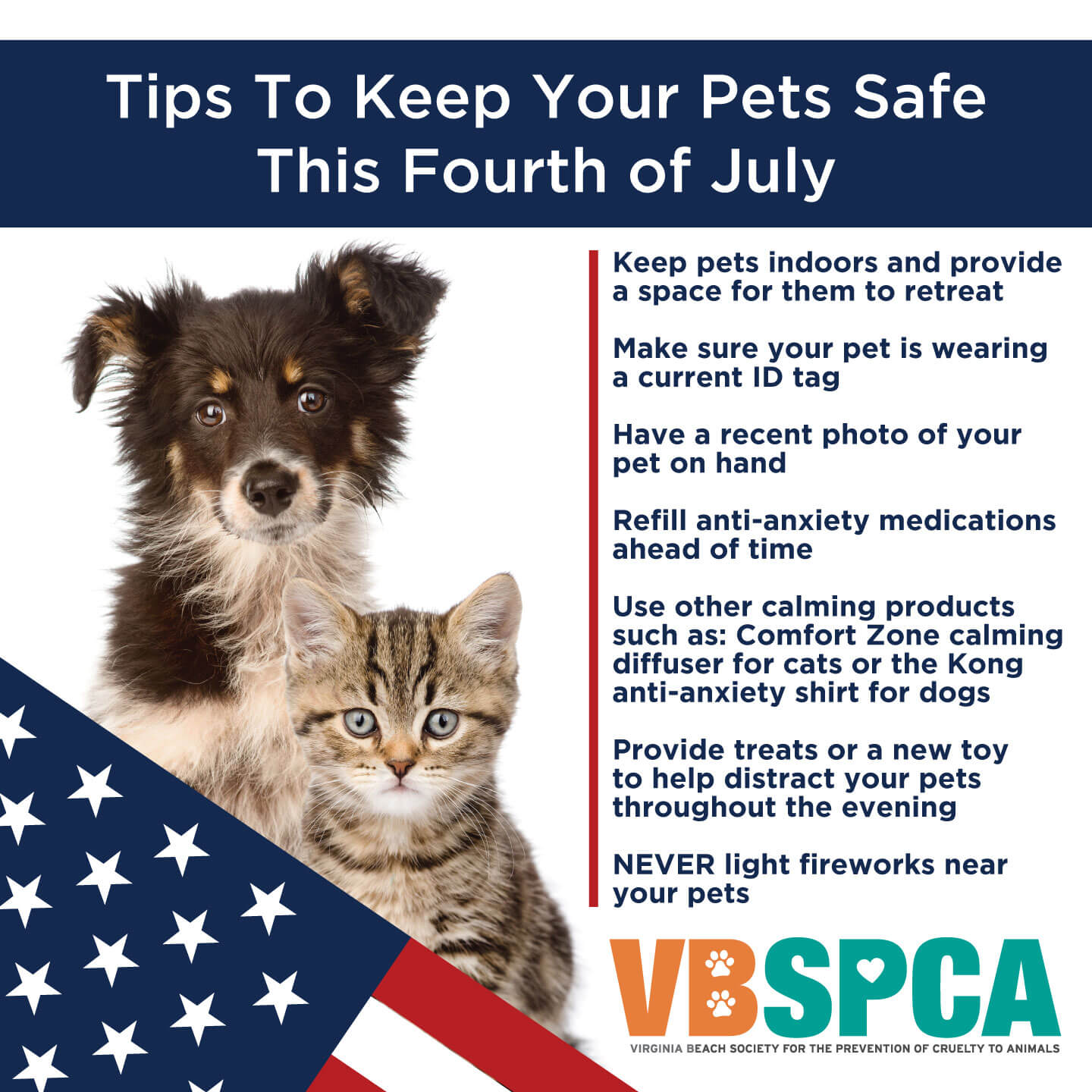
Last Updated: May 27, 2022 by vbspcaadmin
Happy Tails — Squirt
Every single animal that comes through our shelter has a story. Some are complex, many are sad, but all of them get better the minute they arrive at the Virginia Beach SPCA. However, as important of a role as our shelter plays in each story, the happily ever after is why we’re here. The second chances begin with us, but forever is what it’s all about.
VBSPCA adopters are an integral part of our mission, and this month we would like to shine our spotlight on VBSPCA employee and adopter Kat, who welcomed sweet Squirt into her home and gave him the happily ever after he deserved.
How did you first meet Squirt?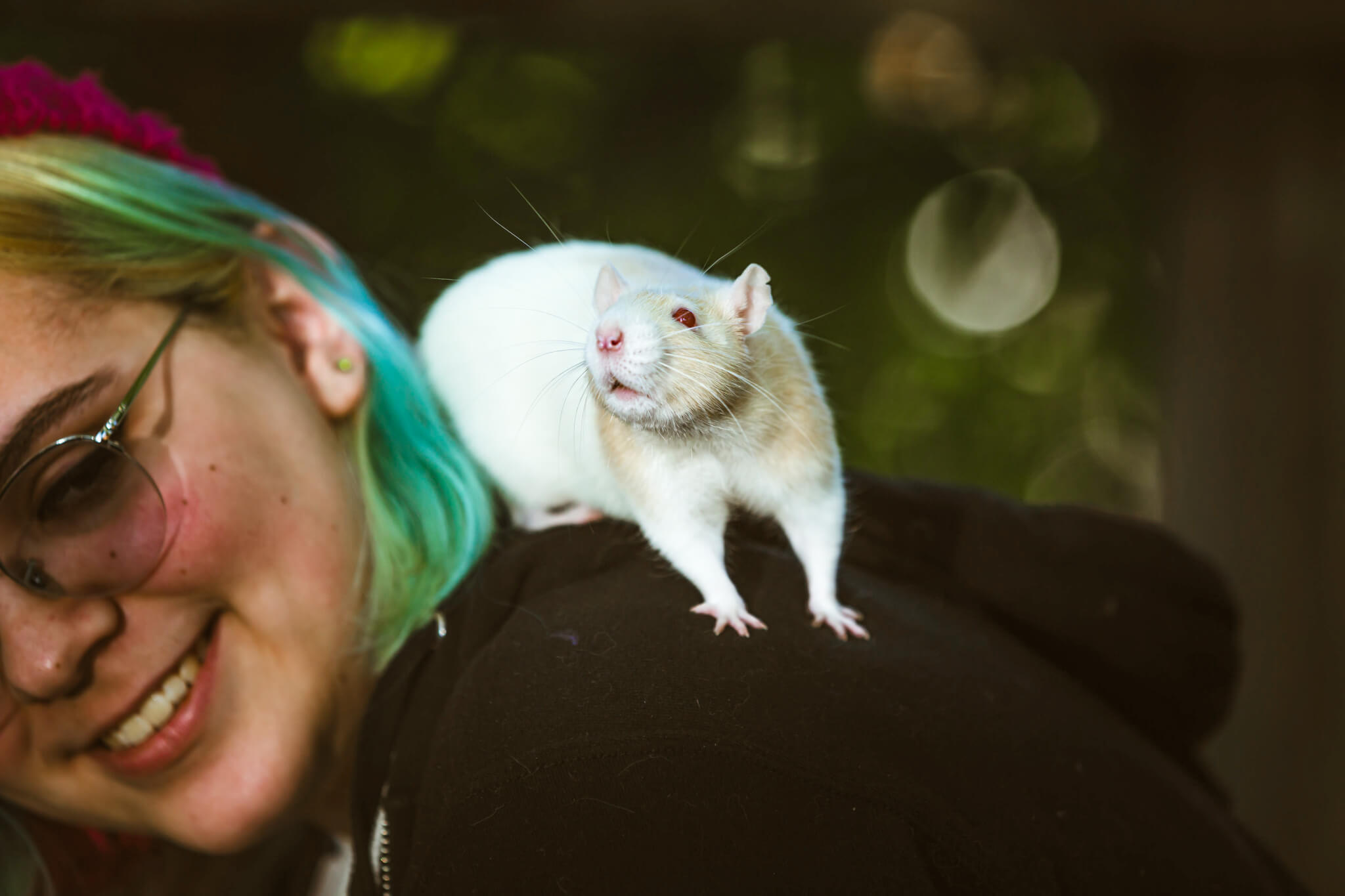
I work at the VBSPCA and Squirt first came to the shelter all the way back in February with his brother Squish. Both of the boys were pretty scared and often nipped at the workers. I began to work on socializing Squish first since he was more shy than scared and it went really smoothly. But then there was Squirt. This little guy had a lot of issues at the shelter. He was scared and often felt he had to defend himself around unfamiliar people. I was offered a chance to foster Squirt to see how he would do in a home environment, and less than a week later I was given the chance to adopt the little guy since he already bonded to me.
How is Squirt doing in the home with the family?
After I had gone to bed that first night with Squirt in the home, my dad picked Squirt up from the cage and let him sit on his shoulder for a few minutes. According to my mom, he had this big, dopey grin on his face and said that Squirt seemed like a “good rat”. When my family adopted him, he acted like a stereotypical dad would and acted like he didn’t care for the rat, but I know he does secretly.
How has Squirt impacted your life since adoption?
I’m just happy I was able to show others how great of a rat he is. I’m really glad I’m able to give him a good home with a lot of love. I always say good morning to him before work and tend to push him into my family members’ faces before bedtime. He’s just been a cute bundle of joy that loves to sit in the hoods of jackets and sweatshirts, which my little sister has plenty of.
Why should someone consider adopting from the VBSPCA?
Families should consider adopting from the VBSPCA because it gives these animals a second chance at love. Sometimes these animals come from bad situations and need a loving family to show them the good in life and bring the best out of them. I’m happy that I could be that for Squirt.
Last Updated: August 18, 2022 by vbspcaadmin
Hurricane Preparedness — Disaster Plan for Pets
The safety of our furry friends is a primary concern for many pet owners during a disaster. With hurricane season officially upon us, now is the time to revisit your disaster plan and ensure that you and your beloved pets are prepared.
Plan Ahead
Find a pet friendly hotel. Keep a list of at least three outside your immediate area.
Prepare an emergency kit for your pets. This should include your vet information, your contact information, gauze wrap, nonstick bandages, hydrogen peroxide, and adhesive tape.
Make sure your pets have an ID tag that is fastened to their collar. If your pet is not microchipped, consider doing so as a safety precaution.
Identify someone who can help. Determine a family member, friend or neighbor who lives nearby and would be willing to take your pets in the event you cannot make it home.
Create a Grab & Go Bag
Stay Informed
Know what disasters could affect your area, which could call for an evacuation and when to shelter in place.
If sheltering in place, know what to do. Make sure you know which rooms are safe, be aware of your pet’s hiding spaces, and close off any small spaces where pets could get stuck.
Download a weather app. Sign up to get weather alerts from the National Weather Service to make sure you are updated as soon as news is available.
What To Do After a Disaster
Observe the environment. Check the area in and around your home to make sure you’re aware of any potential hazards that could harm your pets.
Monitor your pet. Contact your veterinarian immediately if your pets have any prolonged signs of stress, injuries or signs of illness.
Give your pets time. Disasters like hurricanes can be extremely stressful for your pets. Allow them uninterrupted times of rest so they can recover from the trauma. Re-establish a normal routine as quickly as possible, but understand that your pets may need time.
Comfort each other! One of the most beneficial ways to relieve stress is to spend time with your animal friends.
The Virginia Beach SPCA has pet emergency decals available for pet owners. Pick one up and place it on your door or window to alert first responders and rescue teams that there are pets inside the home. Stop by and pick yours up today.
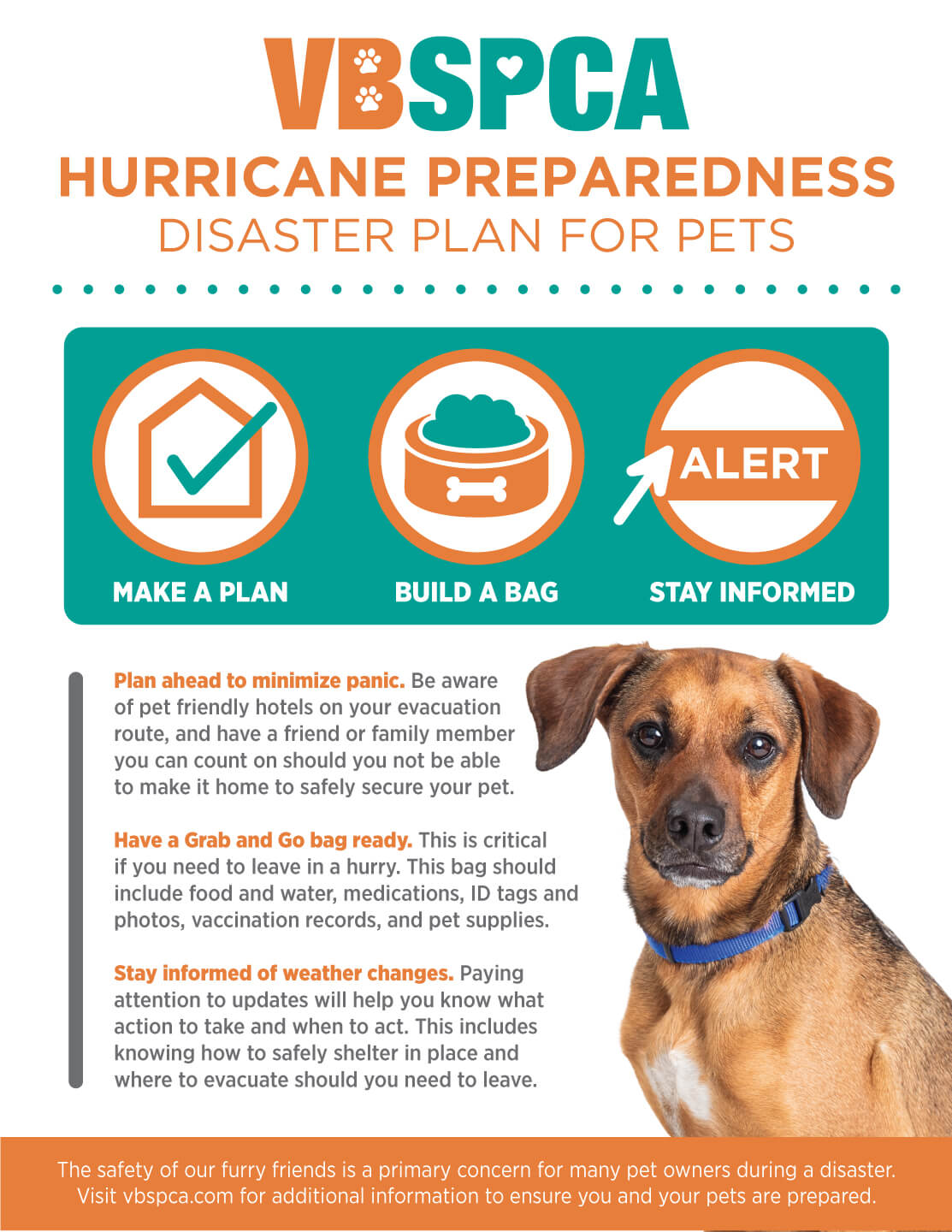
Last Updated: May 1, 2025 by vbspcaadmin
Heartworm Disease: Prevention Matters
As summer approaches, mosquito activity increases, and with more mosquitos comes a higher risk for heartworm disease. Now is the time to brush up on heartworm facts while also making sure your pets are protected from what is a very serious and life threatening situation.
What is heartworm disease? Heartworm disease is caused by Dirofilaria immitis, a parasitic worm transmitted by mosquitoes. If your pet is bitten by a carrier mosquito, microscopic larvae are deposited into the bloodstream, eventually taking up residence in the heart, lungs, and blood vessels. Without treatment, these worms can grow to 14 inches in length, eventually causing irreversible damage to the lungs and heart. Note that it only takes one bite for a dog or cat to be infected, and if your pet is not on prevention medication, your pet will contract the disease. Furthermore, just because you have an indoor pet does not mean there is an absence of risk.
To download our Infographic, click here.
The good news is that this disease can be avoided. There are a variety of heartworm prevention medications for both cats and dogs, and they are proven to be very effective when administered responsibly and correctly. However, if your pet has already contracted heartworm disease, treatment is only available for dogs. Sadly, there is not yet an approved treatment for heartworm positive cats, which makes feline heartworm prevention essential.
Over 20 different species of mosquitoes carry the parasite according to the American Heartworm Society, and they are active at different times of the day and year. Your pet should be on prevention year round.
If your canine is heartworm positive, treatment is serious and takes a minimum of 4 months to complete. It involves bloodwork, chest radiographs, and periods of prescribed rest. The rest is critical because if the heart rate is increased by exercise or excitement, the pieces of the dead worms can be forced into the blood vessels of the lungs, causing a potentially fatal pulmonary embolism.
It is recommended to have your pet tested annually. Heartworms can live for months before symptoms present themselves, and when they do show up, they can often be attributed to other ailments. This means that many pet parents have no idea their animal is heartworm positive. Fortunately, heartworm tests are quick and convenient, and you can access a test via our Walk-In Vaccine Clinic or through your current veterinarian. For a full list of our services, click here.
Over 1 million dogs in the U.S. currently have heartworm disease, and this number does not take into account animals not regularly tested or seen by a vet. Please ensure your pet is protected.
This article relied on information provided by the American Heartworm Society. Visit their website for more information.
Last Updated: May 27, 2022 by vbspcaadmin
Happy Tails – Ollie
Every single animal that comes through our shelter has a story. Some are complex, many are sad, but all of them get better the minute they arrive at the Virginia Beach SPCA. However, as important of a role as our shelter plays in each story, the happily ever after is why we’re here. The second chances begin with us, but forever is what it’s all about.
VBSPCA adopters are an integral part of our mission, and this month we would like to shine our spotlight on VBSPCA friend and adopter Kim who welcomed sweet Ollie into her home and gave him the happily ever after he deserved.
How did you find Ollie?
I am a foster for the Virginia Beach SPCA and I received a message about some puppies who needed temporary care. I am always glad to help no matter what breed, but when I arrived and they brought out Dachshunds, I was really excited. I took two puppies homes to foster, Maverick (now Ollie) and Goose, and I immediately fell in love with them both.
What was Ollie’s story before he came into your life?
He came from a hoarding situation where he was living with 44 other Dachshunds. It was pretty terrible. When the animals were rescued from the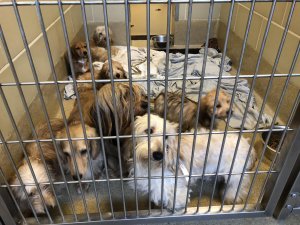 situation, a few different shelters stepped in to help. The Virginia Beach SPCA took 14 of the puppies and I was asked to foster two.
situation, a few different shelters stepped in to help. The Virginia Beach SPCA took 14 of the puppies and I was asked to foster two.
How did you help Ollie build confidence and trust?
His brother Goose has a bigger personality, so Ollie basically followed his brother around and became his shadow. He seemed shy and reserved, even for a puppy. That might be what happens when you live with so many other dogs… you learn to be in the background. However, once Goose went on to a new home, OIlie’s personality began to shine. He didn’t have any trust issues. He is a friend to anyone and is very patient and gentle.
How has he been doing in the home?
We’ve been having a great time watching him grow into his own little personality. He is so fun! There are 3 other dogs in the home and they have formed their own little pack, but his favorite is his Great Pyrenees brother Keigi. They all get along great and they make us laugh alot.
Please share a funny story or experience with Ollie.
Ollie was in the starting lineup for the 2020 Animal Planet Puppy Bowl XVI. Even though he can be such a crazy wild puppy at home, the experience of filming in NYC made him a little camera shy. All the commotion was a bit much, and he wouldn’t play or do anything on the field during the taping. He just wanted everyone to hold him. Although the did get the final play of the entire game, which was fun.
Does Ollie have any funny quirks or habits?
Sometimes he acts like a cat. He stretches like a cat and likes to sleep around the pillows when we are in bed. It’s cute.
How has Ollie enriched your life?
He brings so much love and joy into our home and makes us so happy. I really can’t imagine life without him.
Why should people adopt?
There are so many animals out there in need of a loving home, even pure breeds can be found. All these animals are so loving and appreciative for someone to just give them a chance to let them show how much they can bring to someone’s life. I love the wonderful work they do at the Virginia Beach SPCA. They go above and beyond to help all their animals find loving furever homes.
Last Updated: April 25, 2020 by vbspcaadmin
Pets and COVID-19
We’ve been receiving lots of questions about pets and COVID-19, so we sat down with VBSPCA Medical Director, Dr. AnnMarie Woyma, to get some answers to a few of the most common questions. Keep in mind that this is a new virus and information continues to evolve, so please check back for updates.
Last Updated: May 19, 2025 by vbspcaadmin
Wildlife – Is Human Intervention Necessary?
Spring is particularly busy for the Virginia Beach SPCA as we see baby wildlife being brought to the shelter under the assumption that they have been orphaned. This is often not the case, and it is of critical importance that humans know when wildlife actually needs our help and when it does not. Just because you see a baby creature alone in the wild does not mean it has been abandoned or orphaned. In these situations, human interference can bring unintended harm to the animal and can cause great stress to both the animal and the mother. Below are a few species commonly found in our area along with information to help you identify the best course of action should you come across them in the wild.
Baby Bunnies
Rabbits in burrows in the ground should be left alone. Their mother will only come to feed them twice a day, so just because you do not see the mother does not mean the rabbits are orphaned. Please leave them be.
Baby Birds
Baby birds with feathers that are hopping on the ground are called fledglings, and they are supposed to be on the ground and they are learning how to live. Leave them alone. Baby birds with few feathers may have fallen from the nest. If it is safe to do so, return the baby to the nest.
Squirrels
In most cases, young squirrels do not need help. They are independent at 10-12 weeks and can fend for themselves. If you have found a baby squirrel that has fallen from a tree and does not appear to be injured, keep your pets away from the baby and wait and see if the mother comes to the rescue. The ultimate goal is keep the squirrel with the mother in the environment it was born in.
Turtles
Turtles know where they are going. If you see a turtle crossing the road and is in danger, you may carefully move the turtle to the side of the road in the direction it was headed. It doesn’t need help beyond safely crossing the road. However, if you find a turtle in the road that has a crack in the shell, it needs help.
When help is needed:
The exception to the above is when you come across injured wildlife. It is the mission of the Virginia Beach SPCA to eliminate animal suffering, and our wildlife program is an extension of that. We provide triage services to injured wildlife only, and any wildlife that can be rehabilitated is transferred to a permitted rehabilitator in the community. If you have found injured wildlife that is actively bleeding or wounded or has been in the mouth of a cat or dog, please safely place wildlife in a carrier or shoebox and bring it to the Virginia Beach SPCA during regular operating hours. Please ensure that wildlife is safely secured in a lined box or carrier and do not provide wildlife with food or water. For more information, click here.
If you have found orphaned wildlife that is NOT injured, please contact your local rehabilitator. A full list can be found here. If you have found wildlife in need of rescue, call Tidewater Rescue at 757-255-8710 or Wildlife Response at 757-543-7000.
Search
Ways to Give
Annual Sponsors
To view our Donor Privacy Policy, click here.